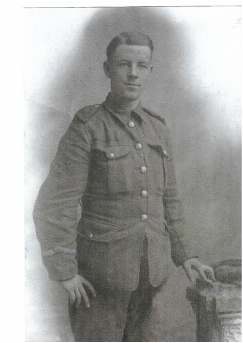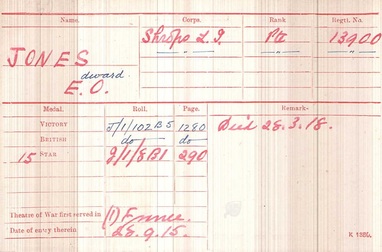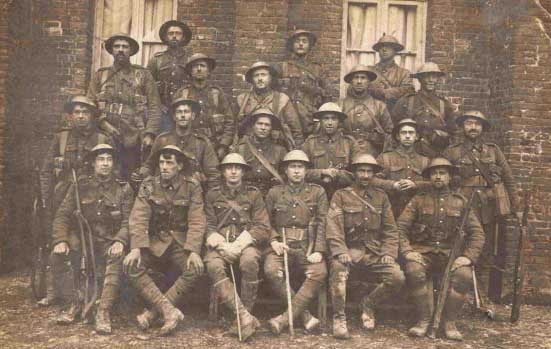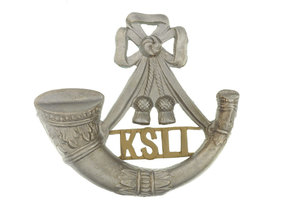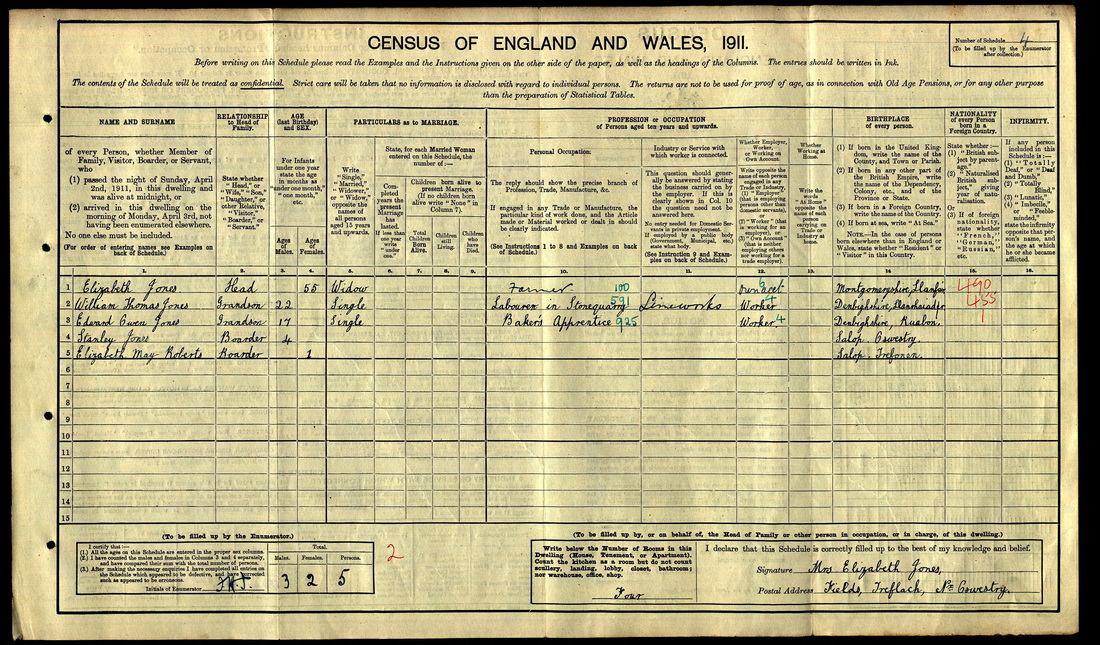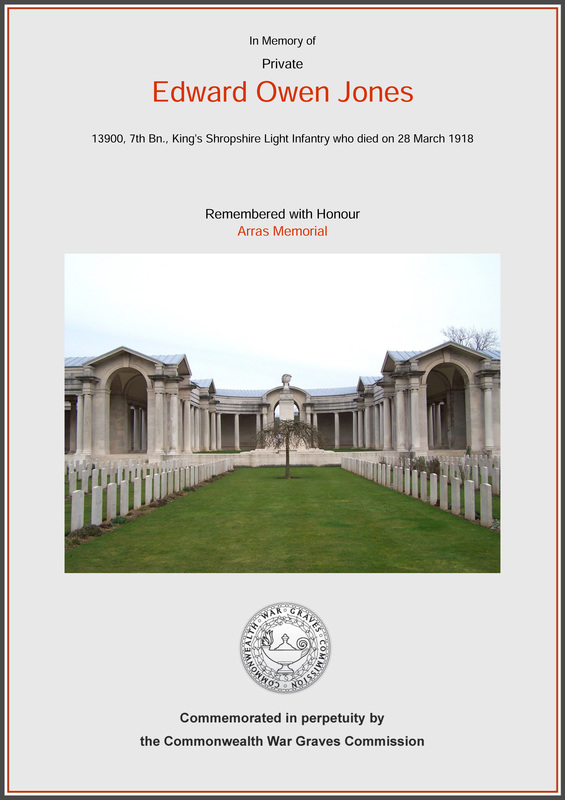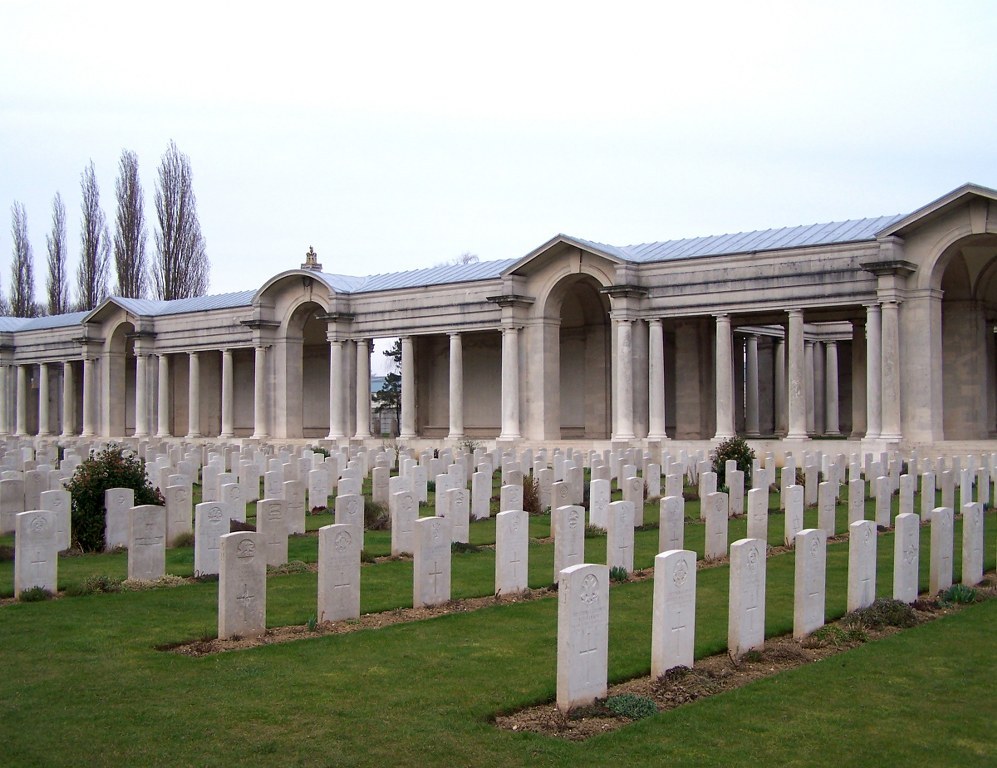Edward Owen Jones
|
Introduction
Edward Owen Jones was born at 17 Jolly Bank, Cefn Bychan, Ruabon on the 14th January 1894 the son of John and Mary Ann Jones. His mother was to die shortly after his birth on the 21/2/1894. The 1901 census has Edward living with his Grandfather and Step Grandmother at the Wern, Treflach. By 1911 he was employed as a bakers apprentice and living at the Fields in Treflach moving to Woodhouse, Hafod Lane, Trefonen in 1912. |
Military Record and Regimental and Battalion Information
|
It is not known exactly when Edward Owen Jones enlisted but his Battalion the 7th Battalion Kings Shropshire Light Infantry was war-raised under Lt. Col. J.H.Barber and was formed in Shrewsbury in September 1914.
It was under the command of the 76th Brigade of the 25th Division; and served entirely on the Western Front. |
It is known however that Edward arrived in France at Boulogne on 28th September 1915 as his Medal Roll Index Card above testifies. They first saw action in the Ypres Salient in the winter of 1915-16 and moved to the Somme in July 1916; where they fought at Bazentin Ridge and then at Serre on the Ancre later in the year. The picture below shows soldiers of the 7th Battalion KSLI just out of trenches at Arras 1917
The Battalion was in action at Arras and in the three severe battles of the Scarpe in April-May 1917. Back in the Ypres sector in 1917, the 7th took part in the fighting at Polygon Wood in September (3rd battle of Ypres) and was back on the Somme for the battles of 1918.
|
Private Edward Owen Jones was to die on the 28th March 1918. The Battalion diaries record the period of March being a quiet one with the soldiers largely involved in digging tunnels and caves and strengthening there positions as well as training. There was no particular incident on that day and it can only be presumed he died of his wounds from an earlier incident. On several days earlier that week the soldiers had been shelled with a number of wounding's and fatalities so it may be one of these incidents was responsible for his death?
|
After taking part in the offensives of summer-autumn of 1918, at Albert, Bapaume, the Canal du Nord and the Selle, the 7th ended the war as part of the 8th Brigade of the 3rd Division, at Romeries, near Solesmes, France.
It was disbanded in Shrewsbury in June 1919.
The 7th suffered more casualties than any other KSLI battalion, with 1048 killed in action or died during the war, and earned more battle honours than any other KSLI battalion..
7th Battalion Battle Honours:
France and Flanders 1915 ; France and Flanders 1916 ; France and Flanders 1917 ; France and Flanders 1918 ; Mount Sorrel; Somme 1916* ; Albert 1916 ; Bazentin ; DelvilIe Wood; Arras 1917* ; Scarpe 1917 ; ArIeux ; Ypres 1917* ; Polygon Wood; Somme 1918* ; St.Quentin ; Bapaume 1918 ; Arras 1918 ; Lys ; Estaires ; Hazebrouk ; Bethune ; Albert 1918 ; Bapaume 1918 ; Canal du Nord ; SeIIe. (26)
It was disbanded in Shrewsbury in June 1919.
The 7th suffered more casualties than any other KSLI battalion, with 1048 killed in action or died during the war, and earned more battle honours than any other KSLI battalion..
7th Battalion Battle Honours:
France and Flanders 1915 ; France and Flanders 1916 ; France and Flanders 1917 ; France and Flanders 1918 ; Mount Sorrel; Somme 1916* ; Albert 1916 ; Bazentin ; DelvilIe Wood; Arras 1917* ; Scarpe 1917 ; ArIeux ; Ypres 1917* ; Polygon Wood; Somme 1918* ; St.Quentin ; Bapaume 1918 ; Arras 1918 ; Lys ; Estaires ; Hazebrouk ; Bethune ; Albert 1918 ; Bapaume 1918 ; Canal du Nord ; SeIIe. (26)
For more information on the Kings Shropshire Light Infantry and there World War One day to day diary please click on the facebook page link below
www.facebook.com/KSLI.Battlefields.tours/
www.facebook.com/KSLI.Battlefields.tours/
Census data
Memorial and War Grave Information
|
Private Edward Owen Jones
13900 Kings Shropshire Light Infantry is Remembered with Honour on the Arras Memorial in Northern France. Historical Information The French handed over Arras to Commonwealth forces in the spring of 1916 and the system of tunnels upon which the town is built were used and developed in preparation for the major offensive planned for April 1917. The Commonwealth section of the FAUBOURG D'AMIENS CEMETERY was begun in March 1916, behind the French military cemetery established earlier. It continued to be used by field ambulances and fighting units until November 1918. |
The cemetery was enlarged after the Armistice when graves were brought in from the battlefields and from two smaller cemeteries in the vicinity.
The cemetery contains over 2,650 Commonwealth burials of the First World War, 10 of which are unidentified. The graves in the French military cemetery were removed after the war to other burial grounds and the land they had occupied was used for the construction of the Arras Memorial and Arras Flying Services Memorial.
The adjacent ARRAS MEMORIAL commemorates almost 35,000 servicemen from the United Kingdom, South Africa and New Zealand who died in the Arras sector between the spring of 1916 and 7 August 1918, the eve of the Advance to Victory, and have no known grave. The most conspicuous events of this period were the Arras offensive of April-May 1917, and the German attack in the spring of 1918. Canadian and Australian servicemen killed in these operations are commemorated by memorials at Vimy and Villers-Bretonneux. A separate memorial remembers those killed in the Battle of Cambrai in 1917.
The adjacent ARRAS FLYING SERVICES MEMORIAL commemorates almost 1,000 airmen of the Royal Naval Air Service, the Royal Flying Corps, and the Royal Air Force, either by attachment from other arms of the forces of the Commonwealth or by original enlistment, who were killed on the whole Western Front and who have no known grave.
During the Second World War, Arras was occupied by United Kingdom forces headquarters until the town was evacuated on 23 May 1940. Arras then remained in German hands until retaken by Commonwealth and Free French forces on 1 September 1944. The 1939-1945 War burials number 8 and comprise 3 soldiers and 4 airmen from the United Kingdom and 1 entirely unidentified casualty. Located between the 2 special memorials of the 1914-1918 War is the special memorial commemorating an officer of the United States Army Air Force, who died during the 1939-1945 War. This special memorial, is inscribed with the words "Believed to be buried in this cemetery". In addition, there are 30 war graves of other nationalities, most of them German.
Both cemetery and memorial were designed by Sir Edwin Lutyens, with sculpture by Sir William Reid Dick. The memorial was unveiled by Lord Trenchard, Marshal of the Royal Air Force on the 31 July 1932 (originally it had been scheduled for 15 May, but due to the sudden death of French President Doumer, as a mark of respect, the ceremony was postponed until July).
On a recent visit to the cemetery (Sept 2015) work was being undertaken to restore the Memorial however access to most areas was still possible.
click on the link below for more information
http://www.cwgc.org/find-a-cemetery/cemetery/82700/ARRAS%20MEMORIAL
The cemetery contains over 2,650 Commonwealth burials of the First World War, 10 of which are unidentified. The graves in the French military cemetery were removed after the war to other burial grounds and the land they had occupied was used for the construction of the Arras Memorial and Arras Flying Services Memorial.
The adjacent ARRAS MEMORIAL commemorates almost 35,000 servicemen from the United Kingdom, South Africa and New Zealand who died in the Arras sector between the spring of 1916 and 7 August 1918, the eve of the Advance to Victory, and have no known grave. The most conspicuous events of this period were the Arras offensive of April-May 1917, and the German attack in the spring of 1918. Canadian and Australian servicemen killed in these operations are commemorated by memorials at Vimy and Villers-Bretonneux. A separate memorial remembers those killed in the Battle of Cambrai in 1917.
The adjacent ARRAS FLYING SERVICES MEMORIAL commemorates almost 1,000 airmen of the Royal Naval Air Service, the Royal Flying Corps, and the Royal Air Force, either by attachment from other arms of the forces of the Commonwealth or by original enlistment, who were killed on the whole Western Front and who have no known grave.
During the Second World War, Arras was occupied by United Kingdom forces headquarters until the town was evacuated on 23 May 1940. Arras then remained in German hands until retaken by Commonwealth and Free French forces on 1 September 1944. The 1939-1945 War burials number 8 and comprise 3 soldiers and 4 airmen from the United Kingdom and 1 entirely unidentified casualty. Located between the 2 special memorials of the 1914-1918 War is the special memorial commemorating an officer of the United States Army Air Force, who died during the 1939-1945 War. This special memorial, is inscribed with the words "Believed to be buried in this cemetery". In addition, there are 30 war graves of other nationalities, most of them German.
Both cemetery and memorial were designed by Sir Edwin Lutyens, with sculpture by Sir William Reid Dick. The memorial was unveiled by Lord Trenchard, Marshal of the Royal Air Force on the 31 July 1932 (originally it had been scheduled for 15 May, but due to the sudden death of French President Doumer, as a mark of respect, the ceremony was postponed until July).
On a recent visit to the cemetery (Sept 2015) work was being undertaken to restore the Memorial however access to most areas was still possible.
click on the link below for more information
http://www.cwgc.org/find-a-cemetery/cemetery/82700/ARRAS%20MEMORIAL
